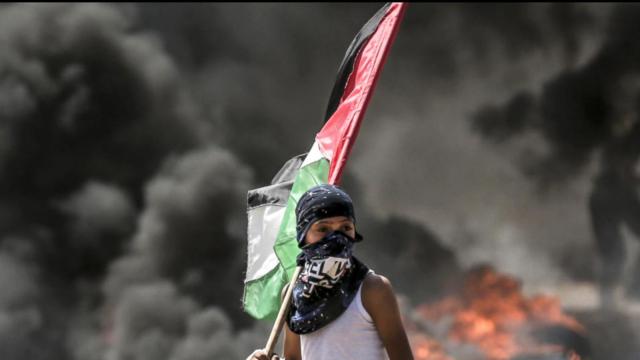
Palestinians bury dead after bloodiest Gaza day since 2014
Palestinians observed a strike Tuesday to mourn dozens killed by Israeli troops in a mass protest on the Gaza border — the single deadliest day there since a 2014 war and part of a high-stakes campaign by Gaza’s Hamas rulers to break a decade-long border blockade.
In Monday’s protest, Israeli forces killed 58 Palestinians, most by gunfire, and injured more than 2,700, Gaza health officials said. In jarring contrast, the U.S. held a festive inauguration ceremony for a new U.S. Embassy in contested Jerusalem just a few miles away.
The juxtaposition of bloodshed on the Gaza border and festivities attended by a high-powered Trump administration delegation — captured on split screens in TV broadcasts around the world — briefly drew attention to the plight of Gaza and its 2 million people.
The high casualty toll also revived international criticism of Israel’s use of lethal force against unarmed protesters. At the same time, the opening of the embassy, condemned by Palestinians as blatantly pro-Israel, further dimmed prospects of what President Donald Trump had once touted as plans to negotiate the Mideast “deal of the century.”
The U.N. Security Council planned to meet Tuesday to discuss the violence, though it was not clear what might come out of the session.
Two U.N. diplomats said members couldn’t reach unanimous agreement on issuing a proposed statement, circulated by Kuwait, that would have expressed “outrage and sorrow” over the killings and sought an independent investigation. The diplomats spoke on condition of anonymity because the discussions were supposed to be private.
For Hamas, the Islamic militant group that seized Gaza in 2007, Monday’s border protest was the culmination of a weeks-long campaign to try to break the blockade. The group led weekly protests near the border with Israel since late March as part of this push.
On Tuesday, there were no signs that Hamas had made a breakthrough in shaking off the blockade that was imposed by Israel and Egypt in 2007. In a sign of an easing, Egypt extended the opening of its border crossing with Gaza, initially set to continue for four days, by two more days, until Thursday. Typically, the Rafah crossing is closed for most of the year.
In recent days, there had been negotiations between Egypt and Hamas, presumably on easing the blockade in exchange for ending the protests.
Hamas has said protests would continue in a weekly format, but it was not clear if it would be able to maintain momentum during the fasting month of Ramadan, which begins this week.
Protest organizers said Tuesday was set aside for funerals, in an apparent attempt to lower expectation of another mass protest later in the day.
Hamas had initially said mass border protests would continue Tuesday, which marks the 70th anniversary of what Palestinians call their “nakba,” or catastrophe — the uprooting of hundreds of thousands in the Mideast war over Israel’s 1948 creation.
The border marches are seen as Hamas’ last hope of ending the blockade that has made it increasingly difficult for the group to govern. Other tactics, including three cross-border wars with Israel in a decade and reconciliation with Hamas’ chief Palestinian rival, West Bank-based President Mahmoud Abbas, have failed.
Monday emerged as the deadliest single day in Gaza since the last Israel-Hamas war in 2014. The Gaza Health Ministry said 58 Palestinians were killed Monday, including 57 by Israeli fire and a baby who died from tear gas inhalation.
Six of those killed by gunfire were minors, the ministry said.
In addition, more than 2,700 people were hurt, among them 1,360 by gunshots. Of the wounded, 130 were in serious or critical condition, it said.
The new wave of injured placed a new burden on Gaza’s already struggling hospitals where key medicines and surgical supplies were lacking even before the latest bloodshed, in part because of the border closures.
Hospitals and other key installations in Gaza, such as sewage treatment and water pumping stations, heavily rely on generators because of hours-long power cuts every day. Gaza’s power crisis was further aggravated last week when vandals destroyed the fuel terminal at Israel’s only cargo crossing into Gaza, halting the flow of fuel and gas.
Israel has defended its actions over the past few weeks, saying troops were defending its border. It also accused Hamas militants of trying to carry out attacks under the cover of the protests, including on Monday.
The Israeli military said its aircraft had struck 11 “terror targets” in a Hamas military compound Monday and that tanks targeted two Hamas posts. It said Gaza activists used 10 explosive devices and firebombs against troops and that shots were fired at soldiers positioned along the border.
Monday’s protest also targeted the opening of the U.S. Embassy in Jerusalem, viewed as a major provocation by the Palestinians and the Arab world.
The Palestinian political camp led by Abbas seeks Israeli-annexed east Jerusalem as the capital of a future Palestinian state.
Trump’s December recognition of Jerusalem as Israel’s capital, followed by Monday’s relocation of the U.S. Embassy from Tel Aviv to Jerusalem, was seen by Abbas as a betrayal. He reiterated Monday that he considers the U.S. unfit to continue as Mideast broker and that he would not accept any peace deal that might be presented by the Trump administration.
He also decided on a series of steps that are bound to anger the U.S. and Israel.
His foreign minister, Riad Malki, said Tuesday that the Palestinians would send a war crimes complaint against Israel to the International Criminal Court, in connection with Israel’s ongoing settlement construction on war-won lands.
The Palestinians have had standing at the court since the U.N. General Assembly recognized a “state of Palestine” as a non-member observer in 2012.
Malki said “Palestine” would also join three international organizations, going against a long-standing U.S. request to avoid this.

